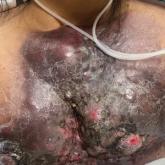Article

Large Indurated Plaque on the Chest With Ulceration and Necrosis
- Author:
- Caroline E. Roberts, BM
- Camilla A. Cascardo, MD
- Georgeanne Cornell, DO
A 47-year-old woman with no notable medical history presented to the emergency department with shortness of breath on simple exertion as well as a...
